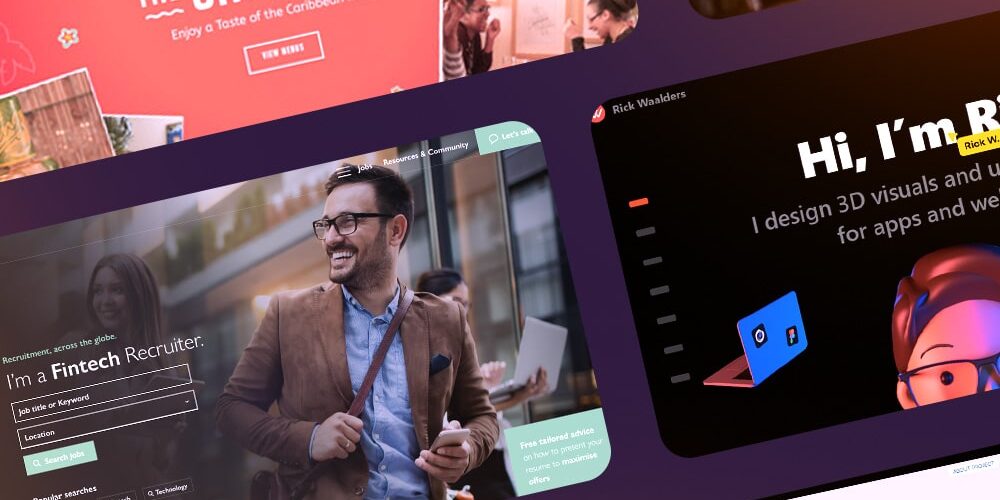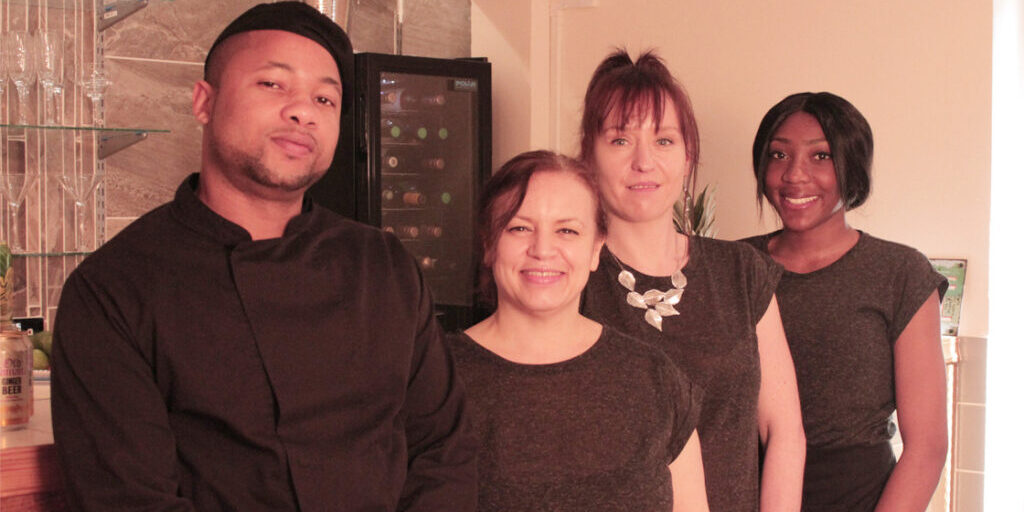When used correctly, Twitter can help to promote and grow your digital brand.
In this article I will explore the different strategies that are available when using Twitter as a marketing tool, and then I will go through some best practices to ensure your Twitter campaign starts off on the right foot.
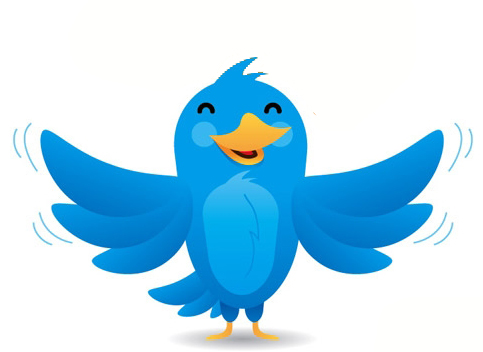
Twitter – A Brief History
Twitter is an online social networking service and microblogging service that began in 2006. It enables users to post and read small (140 character) messages, known as tweets, on the web. As of 2023 Twitter has over 2 billion registered users and is one of the 10 most visited sites on the Internet – read the stats – this site is important to your business!
So with over 400 million tweets a day, it is easy to understand how, when managed properly, Twitter can form a vital part of your digital marketing strategy, and if you are not joining the conversation you could be missing out on a huge opportunity to develop your brand and grow sales.
How it Works
For the newbies out there who have never used it, Twitter is a very public and largely anonymous communications channel. Unless you set your account to private (most people don’t) then anyone can read your tweets, and in the same respect, you can also read the tweets of anyone who has a public profile. Here is a quick run down of the service and some of its features:
Account (Handle)
Ok, you need an account to use the service. This becomes your Handle, it cannot be longer than 15 characters, it must not contain the words ‘admin’ or ‘Twitter’ and you cannot ‘squat’ on someone’s Handle, such as a competitor brand, celebrity etc. Your Handle will be preceded by the @ sign everyone you see it. For example, our Twitter handle is @201digital. Choose your handle wisely!
Tweets
Once you have an account, you can start tweeting and reading other peoples tweets (aka ‘follow’ other Twitter users). Tweets can be no longer than 140 characters and may contain links to images, web sites, videos. Links will consume around 23 characters of your tweet. Generally speaking, people tweet throughout the day from their computer or mobile device, sharing their thoughts, experiences and knowledge in real time.
There are 2 important entries you can place in your tweet that are special to twitter. They are the @ sign and the # (hashtag).
The @ sign
The @ sign is used to link to another Twitter user. By using the @ symbol you are telling Twitter you are referencing another Twitter users Handle. The Handle you reference then becomes a link for other users to click through to that Twitter user, for example:
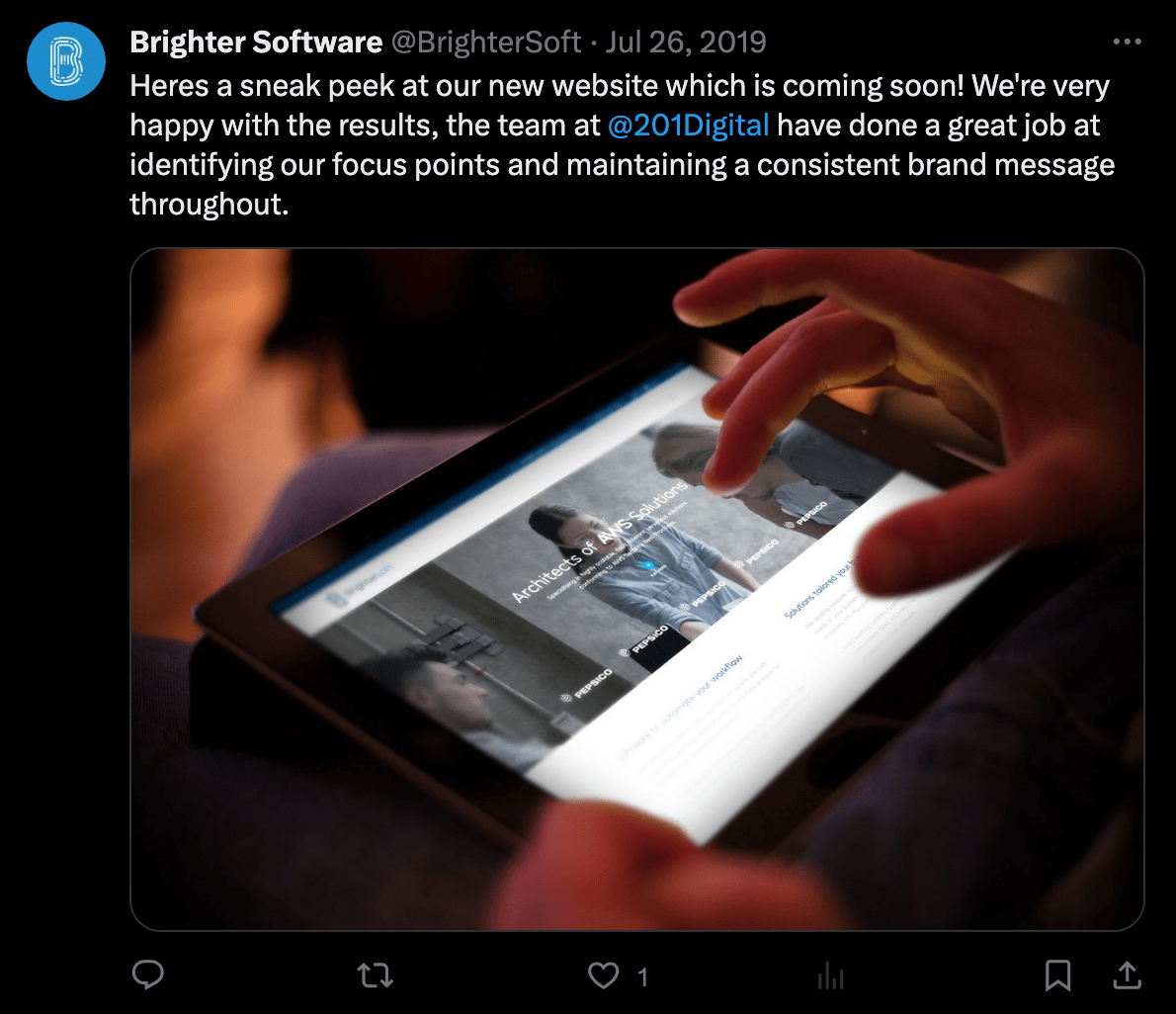
You can see the link in this tweet from @BrighterSoft to @201Digital. We call this a Mention.
Use of the @ sign has two subtle differences in its usage. When a tweet begins with a mention, this is actually a Reply. For example:

Here you can see a reply to the original tweet from @byte_uk, followed by another reply to the first reply @201digital.
The subtle differences between mentions and replies are:
Mentions: Seen by the followers of the original tweet, and in the timeline of the user being mentioned and also in their mentioned tab as it is sort of ‘filed’ in a special place for them too.
Replies: Seen only on the tweeters page, on the recipient’s @ tab, and the timeline of users who are following bother of you.
Replies allow you to have conversations between each other without cluttering up the timeline of users who are only interested in one of you.
Sometimes, you may see a tweet that looks like a Reply, but on close inspection, it begins with a full stop placed before the Mention. This is a technique used when people want to Mention a user, and start the tweet text with the Mention, but don’t want twitter to class the tweet as a Reply!
The # hash tag
People use the hashtag symbol # before a relevant keyword or phrase (without spaces) in their Tweet to categorise their tweet so that it will show up more easily in searches. So in the example above, you can see the hashtag for #QueensSpeach.
When a user clicks on a hash tag, all other tweets containing that hashtag are displayed.
Hashtags can occur anywhere in the Tweet – at the beginning, middle, or end.
Hashtagged words that become very popular are often Trending Topics.
Twitter – A Marketing Tool
Twitter has a whole host of features and opportunities available to the digital marketeer, and when used correctly, Twitter can help you to:
- Build your brand awareness.
- Connect with customers and build relationships.
- Discover what people are saying about you.
- Discover what people are saying about your competitors.
- Create promotional buzz around product launch and events.
- Promote other content such as a blog or web site.
- Generate sales leads.
Lets start looking into how you can achieve these goals.
Accounts
There are 2 types of accounts, business and personal, and your Twitter marketing strategy should utilise both. You must however understand their context and note the subtle differences in the language, tone and content of their tweets!
A company account should represent your organisation as a whole and will only tweet company related information and promotions, and the tone and language should be slightly formal.
A personal account should be used by an employee to provide a more personal feel and may contain both company related tweets and more personal tweets that interest the individual both in and outside of work. This type of account is less direct in sales and marketing, and can be used to grow your companies network of followers indirectly.
Personal accounts should choose a username based on the individuals name and company accounts should choose a username that reflects your brand. Avoid underscores and numbers (unless like us your brand contains numbers!), capitalise where appropriate and no more than 15 characters.
E.g: @BillGates, @CocaColaCo, @BirdsEye, @CostaCoffee
Profile
The first port of call for potential customers checking you out will be your profile page. Your profile is configurable with imagery, a web site address and 160 descriptive words. Capitalise on these features and use them well, especially on your company account. Ensure you complete the profile fields for your name, location and web site. If you want to be really clever and creative, you could tailor a dedicated landing page for your Twitter followers, however this is a more advanced topic, so I will not be able to discuss the opportunities and benefits of this in this post.
Don’t hard sell, be friendly, intelligent and inviting and try to use keywords related to your business so that your profile is search engine positive. General tips would be to include what your company sells, any key projects or events your company is involved in, something your company is proud of, such as innovations and awards.
Do not make the mistake of clicking the “Protect my tweets” option in your profile settings. Your twitter activity will be very limited if you do this!
Imagery
Personal accounts should contain a photo of the individual to give the account that personal feel and let users see who they are exchanging messages with. With company accounts, you should be enhancing your brand and message with quality imagery.
You can upload 3 images, one small square image for your company logo, which will be displayed against each tweet, so make sure it is legible, and 2 background images, one smaller background image for your bio, and another which is used whole page for your timeline.
Take a look at how Dairylea have branded their profile page to promote their message for children to have a healthy diet:
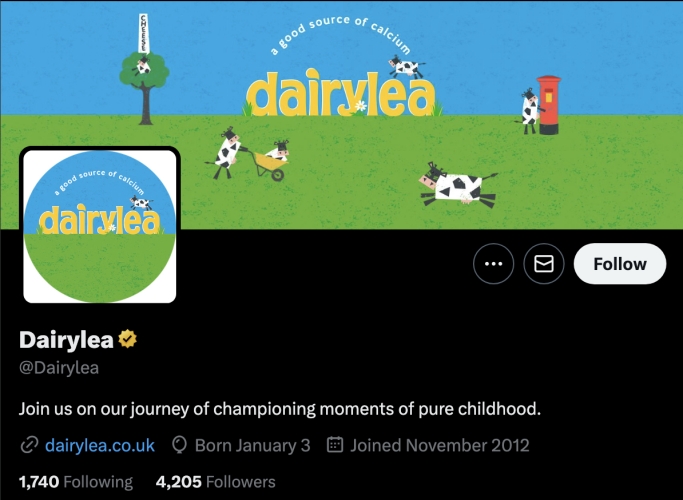
Marketing Your Business with Twitter
In order to start tweeting you need to have things to tweet about! So what should you tweet about?
Well, as we pointed out earlier you may be using both personal and company accounts in your Twitter strategy. Using your personal account, you should be tweeting about your experiences as an employee, things that interest you personally and professionally. Keep some tweets relevant to your job and some more personal. Try to keep your tweets interesting, and engaging where possible. Tweet information about your hobbies and interests, you want to build connections (followers), and so you should find it easy to connect with people who have the same interests!
When you tweet think about including a picture, a video link, or a link to a web site you have visited. Twitter users like to discover new things, so remember to share anything interesting you come across while browsing the net. Lots of sites now have a “Tweet” button making it very easy for you to share their content through Twitter.
You may want to share your frustrations through Twitter, you will find people frustrated with similar problems or situations like to know they are not alone, and you may find they have worked through solutions to similar problems or experiences. When you ask questions or ask if others have had similar experiences you will help to encourage responses and build activity around your Twitter account.
When you are tweeting from your personal account and you are tweeting about work related information, or when you want to sprinkle in a little marketing towards your business, remember to use a mention. That is the @handle for your company twitter account. This will enable your followers to click through and find your company account quickly, and hopefully, if your profile is inviting enough, they will follow your company account too!
From your company account you should be tweeting information relating to products and services. Tweet about any special promotions you have running, or even create a promotion specifically for Twitter. Tweet about your employees and give them a mention when they have achieved something special, such as hitting targets, winning awards, fund raising for charity, etc.
Remember also when tweeting, to use hashtags to add relevance to your tweet. Either create your own hashtags to start a trend, or tweet in response to other hashtags and trending topics.
But Nobody is Listening!
Ok, so you have got to grips with tweeting, and you’ve had some good ideas for things to tweet about. But nobody is listening!
You may feel like this is a chicken and egg situation, what is the point of tweeting if nobody is listening, only problem is, nobody will want to follow you if you dont tweet anything interesting! So you must keep tweeting interesting stuff, promotions, etc. My advise to you when you start out, is to pretend you have a hundred followers.
Build Up Followers…
So how do you build followers? Well, start talking to people about Twitter, tell them you are part of the community and find out if they are too. If they are not, encourage them to join and connect with you. Twitter will keep suggesting people for you to follow. Follow them, see what they have to say, if you don’t like their content you can always unfollow them later and a tip here is that when you follow others, they often follow you back!
List your twitter handle in your stationary, business cards etc and put your Twitter handle in your email signature.
Explore your existing social networks and post an update with your new twitter account details, and ask for your friends to follow you.
Add a follow us button to your company web site and also incorporate your Twitter feed into your web site so that visitors can see what they can expect from your Twitter account, hopefully if your posts are inviting and interesting enough, they will feel more encouraged to follow you.
Use hashtags and tweet in response to trending topics. By using a hashtag, more people will find your tweets and by joining the big conversations (trending topics), you will also create exposure for your Twitter account. Retweet the tweets that you find interesting and think your followers would find interesting too. This also gives kudos to the original tweeter, something they will be grateful for and more reason for them to follow you back.
Be persistent, sometimes this can start of slow before it will gain momentum.
Twitter Power Tips for Business Users
There’s a lot of discussion around the best time to post on Twitter and this is somewhat dictated by the industry that you’re in. However, as a general rule of thumb, think about when your audience are likely to be online, with their Twitter accounts open.
Thanks to mobile, many people access their accounts when they’re at work and according to studies, the hours between 8am and 7pm are premium, with a 30% higher engagement rate.
When you’re starting out, use analytics to determine when your posts are seeing the best engagement, so that you have a starting point to see what works best for your business. Hootsuite is a popular resource for planning tweets, which can be scheduled using the resource and the pro version can also help with best times to post.
Twitter should make up a proportion of an overall digital marketing and content strategy, so by rights, your research should have brought up the best times for your audience, along with tone of posts and so on.
Short is sweet
You only have 140 characters to work with on Twitter, so make them count. Keep tweets short, succinct and to the point and use URL shorteners such as bitly. Shorter posts (less than 100 characters) increase engagement by as much as 17% and the idea is to make sure that the message can be scanned and taken in immediately.
Remember it’s ‘social’
Keep it friendly! A stuffy corporate tone has no place on social media and it should be approached as if you were talking to someone personally. Developing a brand persona means that you should really have decided on the tone and style of written content so ensure your staff stick to it.
Likewise, don’t ignore people unless they are spamming or sending you malicious tweets. Try to reply to people quickly and with a friendly tone and ignore complaints at your peril. Social requires businesses to be transparent, honest and forthcoming, even if someone is slating your product. Reputation management is a big part of your social campaign and should never be ignored.
Twitter, like any other social media site, requires daily posts, timely replies, interesting content and good interaction.
Buying followers
Never, ever be tempted to do this, not only is it morally questionable, but it’s a waste of money and a possible threat to your reputation. It’s easy to spot businesses that have bought followers, not only do their numbers jump overnight, but they have no meaningful interactions, such as retweets, favourites and so on.
If you have an existing Twitter account, or you want to check that it’s being managed properly then Status People allows you to check for fake, inactive and quality followers.

Using hashtags
Hashtags are a handy tool to ensure that you show up in certain searches and can be used in so many ways that they warrant a post all of their own. Make use of keywords, develop a strong primary hashtag and never ride on the back of another’s hashtag success.
Primary hashtag: can be used as a way of strengthening your brand and included on all company stationary. For example, if you’re a florist, then you may choose the hashtag #InBloom and use it on stationary, business cards, landing pages and so on to help raise brand awareness. You can then use it alongside other hashtags that describe content, events, Twitter chat session and so on.
Remember to ensure that it’s legible, #flowershituk reads a lot different to #FlowersHitUK, for instance. Don’t overuse them either and make every single word a hashtag, avoid irony and don’t use long strings of words such as #idontreallyhaveaclueabouttwitter!
Tweets that use hashtags get around 200% better engagement than those without.
Retweet for the win
That old chestnut “you don’t get if you don’t ask” is relevant when it comes to retweets, as studies suggest that those that specifically ask followers to retweet get a huge 1200% more retweets than those that don’t.
Of course, it also helps if you return the favour and retweet interesting, relevant content that your readers will find useful, educating or entertaining (or all).
Quality counts
This should go without saying, but I’m going to anyway. Spelling, grammar and content that you use on Twitter should be impeccable. It always amazes me that I see businesses using text speak on social media and email and it does happen.
Social and online relationships with customers are all about building trust between the brand and consumer. Would you trust a company with your money if they can’t even be bothered to string a decent sentence together? No, so check and double check and remember that you’re aiming for engagement.
Twitter is a powerful business tool and should be utilised by all businesses with a web presence, especially since social signals are becoming more important to SEO all the time. However, you have to have the resources to manage it properly or it’s not worth the bother. This means that during the marketing strategy planning stage, it’s important to either allocate staff, or hire an agency.
Get more leads, make more sales, grow your brand faster.




